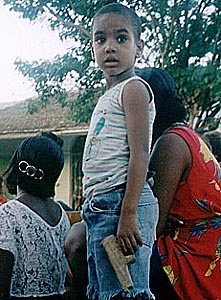
Sun, Salsa & Socialismo
Squall in Cuba - Part 1
Jim Carey travels to Cuba with a fellow SQUALL DJ, to bust a party for the 40th Anniversary of the Cuban Revolution and to meet Cuba's formidable revolutionaries.
July 1999
"Fuck the revolution," scowled the black marketeer striding back to his doorway haunt. Having had his whispered offer of illicit Havanas refused, he'd spotted the Rock Around the Blockade T-shirt and realised we were in Cuba for reasons other than the usual tourist quest for sun, sand, sea, sex and cigars. "How much will you give me if I take you to meet our president?" he scoffed.
The irony stood apparent. Just over forty years ago, an Afro-cuban such as himself might well have been living in a shanty shack on the outskirts of Havana with little access to decent sanitation, employment, medical care or education. The photographs of the period displayed in Havana's Museum of the Revolution depict scenes of poverty and destitution more reminiscent of third world charity appeals; a far cry from both present day Cuba and the well dressed black-marketeer who sneered so dismissively at the political changes in his own country.
Appropriately, the quote written on the back of my duty-free rolling tobacco advised: "Travel the world, talk to everyone". And so, over the course of a one month journey round Cuba, we did just that. From passionate defenders of the revolutionary principle to Nike-obsessed youth gagging for a slice of capitalist excitement. Contrary to what I had read in the British press about Cuba, no-one seemed the least bit afraid to speak their mind, regardless of political perspective. So, as one of the very few countries left in the world actively exploring an alternative to the American way, our journey was always destined to be an education.
'Everywhere you go on the island you'll find a tatty speaker wired up to some tin-box of a radio or tape recorder, farting out fantastic music'
Our first mission in Cuba was a musical one. Myself and a fellow DJ from the SQUALL sound system travelled with a fifteen strong brigade of young British people from Rock Around the Blockade, a pro-Cuban activist group based in the UK. Back in 1995, Rock Around the Blockade asked Cuba's Union de Jovenes Communista (Union of Young Communists) what could be done specifically to help Cuban youth. Rather surprisingly for an island short of certain basic necessities, they replied with a request for a sound system. Upon visiting Cuba it became immediately apparent why; Cubans adore music and dance with unparalleled passion. Everywhere you go on the island you'll find a tatty speaker wired up to some tin-box of a radio or tape recorder, farting fantastic quantities of salsa, merengue, disco, nueva trova, hip-hop, rumba and latin pop. From factories, from farmhouses, from apartments, from the street.....from dawn til long after dusk.
Largely due to the US economic blockade of the island, enforced with a vigour one EU official recently described as "obsessive", music equipment ranks amidst a multitude of material necessities difficult for the Cubans to obtain. And yet for a community powerfully connected by dance, sound systems are a social medicine. And that's where Rock Around the Blockade stepped in for its third visit - on the fortieth anniversary of the Cuban revolution - to give the 36,000 people of Fomento a sound system to keep and a party to remember.

'The Villa Conchita, occupied by a multi-millionaire previous to the revolution, now lends its oppulence to twelve orphans and the impressive eleven care workers who look after them'
Exactly forty years ago this year the Cuban Rebel Army, commanded by Fidel Castro Ruz, succeeded against all odds in deposing the corrupt US backed dictator who had seized power on the island in a coup d'etat eight years previously. Also removed from the island were the Mafia who, with the dictatorship's complicity, had run Havana's numerous clubs, casinos and brothels. Shortly after the revolution the American multinationals and landowners who'd controlled 90% of Cuba's land and industry also got the boot, followed by multi-millionaire corporate Cubans like the Bacardi rum family. The grand headquarters of the Bacardi rum empire - the Edificio Bacardi - had stood just an ingratiated stones throw from the presidential palace in Havana. In a scene irresistibley symbolic of the revolution's reappropriation, the Edificio was swathed in scaffolding as we visited the capital; its cracked marble walls under repair in readiness for state use. A similar fate befell multi-national oil companies with subsidiaries in Cuba. In the immediate aftermath of the revolution these companies began refusing to refine oil in an attempt to bring the new government to its knees.
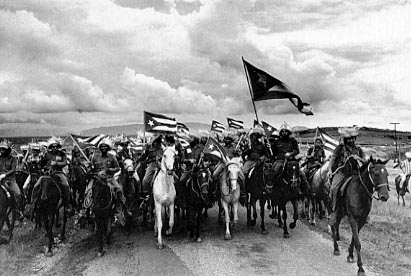
The revolutionary cavalry made up of peasant farmers celebrating victory
Film footage from the period records Cuban people kicking down Texaco, Esso and Shell signs following their government's decision to get rid of the multi-nationals and reappropriate their oil refineries. In order to enact the social principles of the revolution and protect the country from continuing American attempts to force the island back in line, Castro declared the socialist nature of the new Cuban government in 1961. The subsequent reclaimation of Cuba's land and resources is now apparent throughout the island. Grand Spanish colonial architecture, previously occupied exclusively by the white and rich, is now inhabited by everyday folk; black, white and all shades in between. The Villa Conchita, a splendiferous piece of architectural grandeur we visited in the central municipality of Sancti Spiritus, had been occupied by a multi-millionaire previous to the revolution. Complete with much of its original furniture and ornamentation, the Villa now lends its opulence as home to twelve orphans and the impressive eleven care-workers who look after them.
'As part of the revolutionary government's stated principle of avoiding the cult of personality, there are relatively few images of Fidel Castro in public places'
Our brigade's more modest accommodation was shared with a regularly reinforced contingent of large green frogs. Accompanied by these tenacious amphibeans, we spent two weeks in central Cuba staying in a camp of small chalets ordinarily used to accommodate voluntary workers grafting for the revolution in the surrounding coffee plantations. As with all such Cuban worker camps, there was a dance floor complete with ragged-sounding music system and each morning around 7am, the campismo DJ would scuttle into the 'Cabin de Audio' to wake us all up with a tune; a pleasant alarm call when salsa or merengue - but a nightmare at dawn when he insisted on 'Barbie Girl' by Aqua. Behind the chalets loomed an auspicious and well celebrated location in Cuba's revolutionary history; the Escambray mountains. It was from here that Column Eight of the Rebel Army, commanded by Ernesto Che Guevara, conducted the surprisingly rapid take-over of the strategically important central region of Cuba. Castro thought it would take at least three months, but in the end the 300 rebel soldiers of Column Eight took just three days to defeat over 5000 government troops entrenched in the city of Santa Clara. The following day, the dictatorship of Fulgencio Batista fled the island with US$40 million stolen from the state coffers. Eight days later, the rebel army entered Havana.
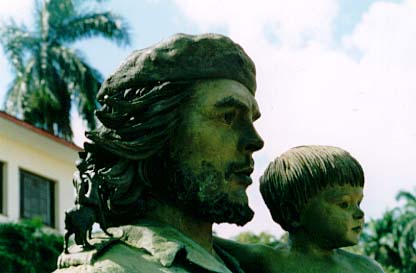
'The prospect of a Hollywood spin on Che Guevara's life story met no applause'
It is simply not possible to exaggerate the reverence with which Che Guevara's memory is held in Cuba. Everyday in schools right across the island, Cuban children repeat: "We aspire to be like Che" as a mantra to self-improvement. Pictures, medallions, statues and memorials to the Argentine-born freedom fighter are everywhere. When I asked one Cuban whether the incessant reverence shown to Guevara ever got on his nerves, the answer was an emphatic 'no'. "Even when he was a commander in the army and a minister in the government, he drew an ordinary soldiers wage," he said. "And even when he was both of these he still occupied his free time doing huge amounts of voluntary work in the plantations and factories despite his chronic asthma. Everybody feels he belonged to the people." Although Guevara is the most memorialised of the revolutionaries, statues and images of his ever smiling comrade Camilo Cienfuego are also profuse, whilst factories, hospitals and street names pay respect to fellow revolutionaries like Celia Sanchez and Tania.
As part of the revolutionary government's stated principle of avoiding the cult of political personality, however, there are relatively few images of Fidel Castro in public places. When told that two movies about the life of Che Guevara were currently in production in United States, the Cubans were unimpressed. Normally they love American action movies plucked from satellite and shown without the necessity for royalty payments; we met passionate communists who were able to recall scene for scene films like Silence of the Lambs, Pulp Fiction, The Godfather and Once Upon a Time in America. But the prospect of a Hollywood spin on Che Guevara's life story met no applause. It was upon the orders of the CIA that Che Guevara was executed without trial in Bolivia in 1967.
'Over the course of several run enhanced sessions, we also had our messy cigar-rolling technique considerabley enhanced, thanks to some humourfully profered Cuban expertise'
Perhaps the one and only passion which Che Guevera shared with the rich capitalists of Hollywood was his legendary love of the mighty Havana. Fulfilling last year's increased export target of 80 million cigars, Cuba's renowned Havanas provide one of the key sources of revenue necessary to ensure Cuba's recent economic growth. Although officially unobtainable in the United States due the economic blockade, US custom seizures of Cuban cigars have risen eightfold over the last few years. Rumours that the infamous Lewinsky blow-job cigar was in fact Cuban remain uninvestigated by American prosecutors, although the new 'Monica Blend' cigars now on sale in the US at $8 a piece, are made with tobacco grown in the Dominican Republic from Cuban seed. Commandante Castro, on the other hand, is unlikely to suffer similar accusations. Long associated with the global image of the Cuban cigar, he actually gave up smoking a couple of years ago citing it as an unhealthy example for young Cubans. Given that he'd smoked cigars everyday for the majority of his life, his sudden abstention at age 71 was impressive.
Although much of the tobacco grown to satiate the world's demand for Cuban cigars comes from the regions of Pinar del Rio in the far west of the island, the Cubans will tell you that the premiero tobacco comes from the smaller, more select acreages of Sancti Spiritus; the region in which we stayed for the first two weeks of our month's journey. Courtesy of several hospitable guajiros (farmers) in the area, yer SQUALL ambassadors were inundated with cigars made from local leaf and rolled between the tobacco-stained spades they possess for hands. Over the course of several rum enhanced sessions, we also had our messy cigar-rolling technique considerably enhanced, thanks to some humourfully profered expertise. Late one night and before an audience of ten beaming Cubans, we were presented with a fine eight-incher by a proud local roller and a round of applause errupted as the monster log lit first time and our smoke rings sent the swarm of ever greedy Cuban mosquito's fleeing in horror.
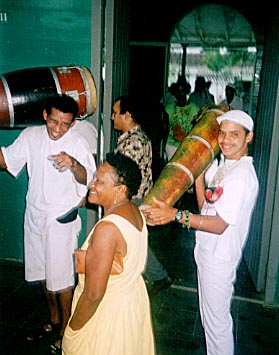
'The headline salsa act simply refused to go on; not out of political objection but through an awed respect for the quality of the Cuban's musicianship'
Another source of both revenue and international representation are the increasing number of Cuban artists travelling abroad to perform in Europe as well as countries like Japan, Mexico, Canada and even the United States. According to Fernando Leon Jacamino from the organisation responsible for the development of Cuban culture (SAIZ), there are now more Cuban bands performing abroad than at any time in the country's history, with Europe currently providing the most frequented destination. Schools of music in Cuba provide a free education in the combined disciplines of afro-cuban, jazz and classical. As a legacy of musical exchanges with the former Soviet Union there are still Russian professors teaching classical techniques in the music schools of Havana.
State support for culture combined with a long celebrated and well developed confluence of African and European musical styles has cultivated a unique quality of musicianship inside Cuba - the country that gave the world salsa, rumba, cha-cha-cha, bolero, latin jazz and mambo. Despite the bureaucratic obstacles put before Cuban musicians entering the US, it is still possible for Cuban bands, signed to economically powerful record companies, to perform in America.
Anancys Saxon, the woman specifically responsible for music with the SAIZ organisation, told us that with hispanic people now forming the biggest ethnic group in the United States, market demand for Cuban music there is strong. When La Charanga Habenera, one of Cuba's top salsa outfits, was finally allowed into the United States to perform as a support band, the audience response was raptuous. The headline salsa act, Peter Conde, simply refused to go on; not out of political objection but through an awed respect for the quality of the Cuban's musicianship. Such stories were fully corroborated as we sat in an small cafe just outside Havana. With just two SQUALL DJs for an audience, Son del Barrio set up in the corner and proceeded to pour out tune after tune of sublime yet fiery acoustic music. The percussion player, equiped with just a set of bongos and a cowbell, played like a demon and sounded like an entire percussion troupe.
'In the socialist aftermath of the revolution all homelessness, unemployment and malnutrition had been eradicated from a country which - we had to constantly remind ourselves - is classed as a Third World State'
The largest source of international revenue going into the Cuban economy these days comes from an industry the revolutionary government had deliberately avoided developing; the dreaded tourism.
With the United States persuading all but a handful of countries to comply with its economic blockade, the Cuban revolution had been left with no option but to rely on the Soviet Union as its principle trading partner. In the socialist aftermath of the revolution all homelessness, unemployment and malnutrition had been eradicated from a country which - we had to constantly remind ourselves - is classed as a third world state.
A free education system had raised Cuba's literacy rate to a level higher than that of the US, whilst its health system had dramatically decreased infant mortality as well as increasing the number of doctors and ridding the island of yellow fever and meningitis (Cuba has four times as many doctors per capita as the UK and fosters an internationally renowned reputation for medical research).
With the 85 per cent collapse in trade occuring subsequent to the breakdown of the Soviet Union at the end of the eighties, Cuba's entire social infrastructure stood on the brink of collapse. Whilst the Cuban government declared a Special Period of rationing, anti-Castro groups in the United States, supported by the CIA, stepped up their efforts to instigate dissent on the island. The capitalist world, and particularly the United States, drummed its fingers in anticipation of the revolution's imminent demise. It never came. The fact that not one single hospital, school, day care centre or orphanage closed down in Cuba as a result of this crisis stands as a formidable testament to an extraordinary feat of economic juggling.
Principle to this survival was the Cuban government's decision to develop what has now become one of the fastest growing tourist industries in the world. Previous to this crisis, Cuba had resisted the temptation to exploit the island's obvious potential as a tourist hot spot largely due to the prospective social problems accompanying an influx of rich holiday-makers onto an island with an average wage of $10 a month. But the tourists now come in their rapidly increasing thousands and along with their wads of cash, they have brought their predicted social disruption.
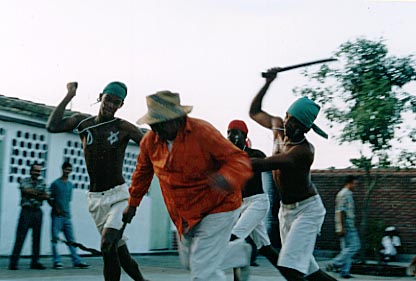
A ritual renactment of Cuba's slave uprising in the late 1800's
'The Cubans, half of whom are black, love sport with the same passion they devote to music and revolution'
I didn't notice it at first as I lay on my bed lost in thought. But eventually my eyes fell in disbelief on an all too familiar logo graffitied in biro on the chipboard base of the campismo bunk above me. "Oh no, not here as well," I cried aloud. "Nike!".
Over the course of the next four weeks it would prove to be a common sight. Scrawled on walls, sewn onto baseball caps, stickered in windscreens and even barbared in the hair of a dog I tripped over in Havana. Some Cubans even used marker pens to logo their white T-shirts. At least some of the explanation for this fashion fad is ascribable to Nike's marketing strategy.
Despite being a corporation run by white American businessmen, Nike made a decision early on to use black sports stars like Michael Jordan, the American basketball player, and Ronaldo, the Brazilian footballer, to endorse their products. The Cubans, half of whom are black, love sport with the same passion they devote to both music and revolution. Although Nike products - if you can get hold of them in Cuba - are hugely expensive, the youth of the country are clearly attracted by the lure of the logo through exposure to international sporting events and to music videos featuring artists smothered in ticks. Further exposure to the lure comes from the logoed tourists now flooding into Cuba.
The quote on my second packet of duty-free rolling tobacco offered yet more appropriate wisdom: "You can tell a nation's ideals by looking at its adverts". Whilst Cuban communist propaganda bangs on about homelessness, racism, education and health, US capitalist propaganda bangs on about alluring products you're not hip without. The Afro-cuban who'd offered us the illicit cigars outside the factory - the one who'd said 'fuck the revolution' - the one whose parents had probably lived in a pre-revolutionary shithole - was covered head to toe in logoed sports gear. Despite western media assertions about Cuba, I was left in little doubt which of the two forms of propaganda was the more insidious, and therefore which of the two nation's ideals were the more worthy. I gleaned another insight into the nature of the fad when I saw the receptionist at the Union of Young Communists (UJC) headquarters in central Havana wearing an Operation Desert Storm sweat-shirt complete with a picture of an American F1-11! "To her it's just English writing with an action picture on it," explained the English-speaking UJC worker I asked.
'The vast majority of Western media coverage about Cuba proved both grossly inaccurate and alarmingly complicit with America's hysterical posturing'
The detrimental effects of Cuba's development of tourism can be most keenly observed in the capital and we were fortunate for having started our journey in the Cuban countryside. The incredible hospitality and revolutionary fervour displayed by the Cuban campesinos gave me a context with which to view the capital's preoccupation with the dollar; particularly that displayed by Havana's youth.
If a Cuban citizen had been caught with dollars in the eighties they would be questioned by police about black market activities. The government had resisted the use of a currency belonging to its arch enemy United States and ordinary Cubans weren't supposed to break the line . However, with the advent of tourist dollars, the recent condoning of certain small businesses associated with tourism and the increasing number of dollars sent into the country from relatives and friends abroad, the authorities changed its position. There are now currency exchange booths on most streets and Cubans, as well as tourists, can shop in the numerous Tiendas dollar stores.
As a result there are now three exchangeable currencies in the country. The first is Peso Cubano ($1=20 pesos) used almost exclusively by Cuban nationals to buy food, clothing, cigarettes and other products and services at extremely low prices. The second is US dollars used by tourists and some Cuban nationals to buy a far greater range of products at very expensive prices. The third is an unusual form of currency called the national tourist peso directly exchangeable with dollars ($1=1 peso tourismo) and an attempt to maintain some form of national Cuban currency with equivalent value to the dollar, ready for the time when Cuba's reluctant use of US currency will cease. Whilst I was still in Havana, Fidel Castro held a joint press conference with Belgium's visiting foreign minister, to reveal that the Euro will replace the dollar as Cuba's international exchange currency as soon as possible.
Aphorisms abound in Cuba. This was one of SQUALL's favourites: "An informed people will never be defeated"
At present, a Cuban stands to make the equivalent of one month's average wage simply through a single black market transaction of cigars, drugs or prostitutes. It is tourists who provide the market; both are on the increase.
It is a clear indication of the continuing support for the ideals and social benefits of the revolution that the vast majority of the population resist such large temptations. For those that don't, stringent new laws are immanent. I watched live TV coverage of a stern Fidel Castro informing the National Revolutionary Police during their 40th anniversary conference, that pimps, drug sellers and thieves would now be receiving 20 to 30 year prison sentences. (Prostitutes - unless they are repeat offenders - are sent to a reform centre where attempts are made to provide them with further education and employment skills before returning them to their original communities).
Before travelling to Cuba, people with an opinion on the subject cast doubt as to whether Cuba's unique style of communism would survive without its 73 year old leader, Fidel Castro. In answer to our enquiries it became apparent the Cuban people are emphatically sure a new leader is ready to take the presidential seat in the event of Castro's retirement or death. The preferred selections of those we posed the question to coalesced around Carlos Lago - the general Secretary of the Cuban Communist Party and the man who suggested using Cuba's tourism as a weapon in the battle for principled economic survival. Like Fidel, they say, Lago has the multi-skilled open mind necessary to be president. Even those who didn't necessarily like Castro - and it has to be said that they are very much in the minority - acknowledged that he remains in full possession of his mental faculties at 73. One story related to us by several Cubans occured recently at a press conference. Castro was asked to come up with a word that contained 5 'i's. "That is a very difficult question," he replied to the Columbian journalist who had thrown the googly. In Spanish the word for difficult is dificilisimo.
Upon investigation, the vast majority of western media coverage about Cuba proved both grossly inaccurate and alarmingly complicit with America's often hysterical posturing. The significance of Cuba's stance against US driven global capitalism grows ever greater as the rest of the world forsakes its independent thought. Who else is prepared to go into the World Trade Organisation and the United Nations to point out that money only makes a rich man's world go round. Perhaps then, this is the reason why a third world island with a population of just 11 million people presents such an apparent threat to the American spell.
In part 2 of the 'SQUALL in Cuba' saga: DJ's and revolution
**children and booby traps
**freemasonry in Cuba
**why SQUALL Magazine would be banned in Cuba
DO YOU HAVE ANY COMMENTS ON EITHER THIS ARTICLE OR CUBA IN GENERAL? E-MAIL US.
Wanna get involved in donating sound systems to Cuba?
Write to: Rock Around the Blockade, BCM 5909, London WC1N 3XX
